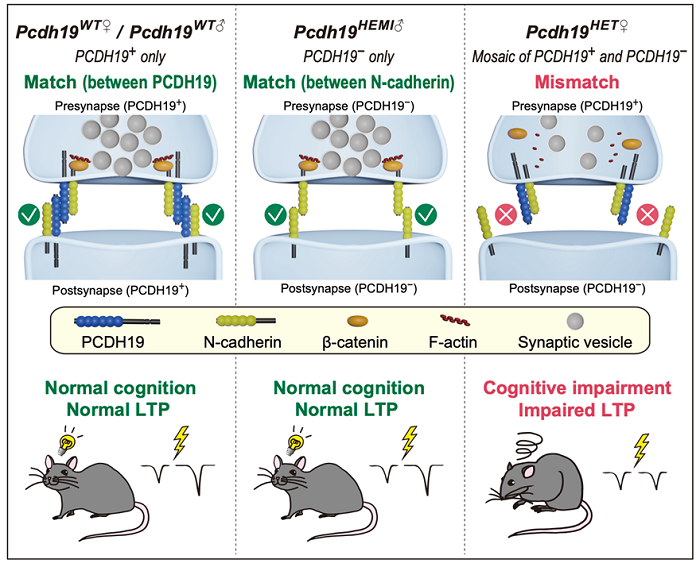By Erin Johnson-Venkatesh and Hisashi Umemori
PCDH19-related disorder with epilepsy and cognitive impairment is a disorder that occurs primarily in girls. This disorder arises from mutations in the PCDH19 gene, which is located on the X-chromosome. Typically, X-linked disorders more severely manifest in males, who only have one copy of the X-chromosome, than in females, who have two copies. This disease expression pattern is reversed in PCDH19-related disorder, where boys usually present as typical boys. Why this is the case is not known. The PCDH19 gene encodes a protein that is a cell adhesion molecule, located on both sides of a synapse. The Pcdh19 proteins bind with each another across the synaptic cleft. One place that PCDH19 is expressed is at a specialized synapse in the hippocampus called the mossy fiber synapse.
To discover why PCDH19 is associated with a female-specific disorder, we inactivated one copy of Pcdh19 in mice, and investigated the development of mossy fiber synapses. In a female mutant, some cells will express PCDH19 and some will not due to random X-inactivation (in every cell of the female body, the X-chromosome from either the mother or the father is silenced). We found that females with one copy of Pcdh19 had smaller synapses and these synapses had impaired long-term potentiation (LTP), a form of plasticity. These mice also had impaired mossy fiber synapse-dependent cognitive behavior. No problems were found in male mice lacking Pcdh19. Since male mutants are normal, we hypothesized that PCDH19 interacts with another cell adhesion molecule and activating downstream signaling. We found that this molecule is N-cadherin. In female mice with two copies of Pcdh19, PCDH19 is expressed by all neurons so that it binds across the mossy fiber synapse and induces downstream N-cadherin signaling. In male mice with no Pcdh19, unmasked N-cadherin molecules can bind with each other across the synapse to induce the same downstream signaling. In female mice with one copy of Pcdh19, there is a mismatch between synapses that express PCDH19 on one side and only N-cadherin on the other and so no downstream signaling happens. To further confirm this mismatch hypothesis, we overexpressed N-cadherin in female mice expressing only one copy of Pcdh19, and found that we could rescue the synaptic phenotype and LTP deficits. This research may point to a new therapeutic strategy to treat PCDH19-related disorder based on the molecular interaction we identified.

A mismatch model for PCDH19-related disorder with epilepsy and cognitive impairment.
In wild-type mice, PCDH19 binds with itself across the synapse and activates N-cadherin signaling to induce β-catenin clustering. These mice have normal cognition and long term potentiation (LTP). In male mutant mice (HEMI), which lack PCDH19, N-cadherin is unmasked and can bind to itself to cluster β-catenin so that cognition and LTP is normal. In female mutant mice with one copy of PCDH19 (HET), N-cadherin remains masked on one side of the synapse so that β-catenin cannot cluster, and cognition and LTP are impaired.
Erin Johnson-Venkatesh is a postdoc in the Umemori lab in the Kirby Neurobiology Center at Boston Children’s Hospital.
Hisashi Umemori is an Associate Professor of Neurology at Harvard Medical School and the Kirby Neurobiology Center at Boston Children’s Hospital.
Learn more in the original research article:
Female-specific synaptic dysfunction and cognitive impairment in a mouse model of PCDH19 disorder.
Hoshina N, Johnson-Venkatesh EM, Hoshina M, Umemori H. Science. 2021 Apr 16;372(6539):eaaz3893. doi: 10.1126/science.aaz3893. PMID: 33859005.
News Types: Community Stories
